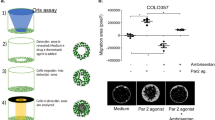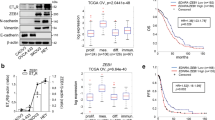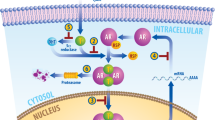Key Points
-
Studies have demonstrated the role of the ET axis in a wide variety of diseases, including cancer.
-
ETA-receptor activation by ET-1 contributes to tumour growth and progression, inducing cell proliferation, survival, angiogenesis and metastatic spread, indicating that ETA-receptor blockade might improve cancer treatment.
-
In Phase I and II clinical studies, ETA-receptor antagonists can be administered orally, once a day, and have a favourable tolerability profile.
-
Preliminary data from clinical trials are promising.
-
Studies are underway to better define the role and ET-receptor antagonists in the treatment of malignant diseases.
Abstract
Collectively, the endothelins and their receptors — referred to as the endothelin (ET) axis — have key physiological functions in normal tissue, acting as modulators of vasomotor tone, tissue differentiation, development, cell proliferation and hormone production. Based on new data, the ET axis also functions in the growth and progression of various tumours. Preliminary results from clinical trials, such as those with atrasentan — an ETA-receptor antagonist — in prostate cancer, are encouraging. The place of ET-receptor antagonists in cancer therapy for a range of malignancies merits further investigation.
This is a preview of subscription content, access via your institution
Access options
Subscribe to this journal
Receive 12 print issues and online access
$209.00 per year
only $17.42 per issue
Buy this article
- Purchase on Springer Link
- Instant access to full article PDF
Prices may be subject to local taxes which are calculated during checkout




Similar content being viewed by others
Change history
03 February 2005
'a' added to first page numbers for references 40 and 53; acknowledgement added
References
Levin, E. R. Endothelins. N. Engl. J. Med. 333, 356–363 (1995).
Goldie, R. G. Endothelins in health and disease: an overview. Clin. Exp. Pharmacol. Physiol. 26, 145–148 (1999).
Walden, P. D., Ittmann, M., Monaco, M. E. & Lepor, H. Endothelin-1 production and agonist activities in cultured prostate-derived cells: implications for regulation of endothelin bioactivity and bioavailability in prostatic hyperplasia. Prostate 34, 241–250 (1998).
Masaki, T. The endothelin family: an overview. J. Cardiovasc. Pharmacol. 35, S3–S5 (2000).
Valdenaire, O., Rohrbacher, E. & Mattei, M. G. Organization of the gene encoding the human endothelin-converting enzyme (ECE-1). J. Biol. Chem. 270, 29794–29798 (1995).
Bagnato, A. & Catt, K. J. Endothelin as autocrine regulators of tumor cell growth. Trends Endocr. Metab. 9, 378–383 (1998).
Bloch, K. D. et al. Structural organization and chromosomal assignment of the gene encoding endothelin. J. Biol. Chem. 264, 10851–10857 (1989).
Battistini, B., Chailler, P., D'Orleans-Juste, P., Briere, N. & Sirois, P. Growth regulatory properties of endothelins. Peptides 14, 385–399 (1993).
Nelson, J. B. & Carducci, M. A. The role of the endothelin axis in prostate cancer. Prostate J. 1, 126–130 (1999).
Remuzzi, G., Perico, N. & Benigni, A. New therapeutics that antagonize endothelin: promises and frustrations. Nature Rev. Drug Disc. 1, 986–1000 (2002).
Pristivishalil, G. & Nelson, J. B. Endothelium-derived factors as paracrine mediators of prostate cancer progression. Prostate 44, 77–87 (2000).
Opgenorth, T. J. Endothelin receptor antagonism. Adv. Pharmacol. 33, 1–65 (1995).
Lusher, T. F. & Barton, M. Endothelins and endothelin receptor antagonists: therapeutic considerations for a novel class of cardiovascular drugs. Circulation 102, 2434–2440 (2000).
Clozel, M. Endothelin receptor antagonists: current status and perspectives. J. Cardiovasc. Pharmacol. 35 (Suppl. 2), S65–S68 (2000).
Today in Cardiology news source. Cardiovascular Drugs in the Pipeline [online], (cited 1 Dec 2002), <www.todayincardiology.com/200301/pipeline.pdf> (2003).
Nelson, J. B. et al. Endothelin-1 production and decreased endothelin B receptor expression in advanced prostate cancer. Cancer Res. 56, 663–668 (1996).
Daub, H. et al. Role of transactivation of the EGF receptor in signaling by G-protein-coupled receptors. Nature 379, 557–560 (1996).
Vacca, F., Bagnato, A., Catt, K. J. & Tecce, R. Transactivation of the epidermal growth factor receptor in endothelin-1-induced mitogenic signaling in human ovarian carcinoma cells. Cancer Res. 60, 5310–5317 (2000).
Filippatos, G. S. et al. Regulation of apoptosis by vasoactive peptides. Am. J. Physiol. Lung Cell. Mol. Physiol. 281, L749–L761 (2001).
Wu-Wong, J. R., Chiou, W. J., Dickinson, R. & Opgenorth, T. J. Endothelin attenuates apoptosis in human smooth muscle cells. Biochem. J. 328, 733–737 (1997).
Wu-Wong, J. R., Chiou, W. J. & Wang, J. Extracellular signal-regulated kinases are involved in the antiapoptotic effect of endothelin-1. J. Pharmacol. Exp. Ther. 293, 514–521 (2000).
Shichiri, M., Kato, H., Marumo, F. & Hirata, Y. Endothelin-1 as an autocrine/paracrine apoptosis survival factor for endothelial cells. Hypertension 30, 1198–1203 (1997).
Eberl, L. P., Egidy, G., Pinet, F. & Juillerat-Jeanneret, L. Endothelin receptor blockade potentiates FasL-induced apoptosis in colon carcinoma cells via the protein kinase C-pathway. J. Cardiovasc. Pharmacol. 36, S354–S356 (2000).
Eberl, L. P., Valdenaire, O., Saintgiorgio, V., Jeannin, J. F. & Juillerat-Jeanneret, L. Endothelin receptor blockade potentiates FasL-induced apoptosis in rat colon carcinoma cells. Int. J. Cancer 86, 182–187 (2000). ET-1 seems to act as a survival factor against FAS-ligand-induced apoptosis. In vivo , however, mixed ET A /ET B -receptor antagonism did not control tumour progression.
Nelson, J. B. et al. New bone formation in an osteoblastic tumor model is increased by endothelin-1 overexpression and decreased by endothelin A receptor blockade. Urology 53, 1063–1069 (1999). First in vivo demonstration of the effects of ET-1 and ET A -receptor antagonism in the osteoblastic response.
Boyce, B. F., Yoneda, T. & Guise, T. A. Factors regulating the growth of metastatic cancer in bone. Endocrine-Related Cancer 6, 333–347 (1999).
Mundy, G. R. Metastasis to bone: causes, consequences and therapeutic opportunities. Nature Rev. Cancer 2, 584–593 (2002).
Guise, T. A. Molecular mechanisms of osteolytic bone metastases. Cancer 88 (Suppl.), 2892–2898 (2000).
Chiao, J. W. et al. Endothelin-1 from prostate cancer cells is enhanced by bone contact which blocks osteoclastic bone resorption. Br. J. Cancer 83, 360–365 (2000).
Salani, D. et al. Role of endothelin-1 in neovascularization of ovarian carcinoma. Am. J. Pathol. 157, 1537–1547 (2000).
Bek, E. L. & McMillen, M. A. Endothelins are angiogenic. J. Cardiovasc. Pharmacol. 36, S135–S139 (2000).
Bagnato, A. et al. Expression of endothelin 1 and endothelin A receptor in ovarian carcinoma: evidence for an autocrine role in tumor growth. Cancer Res. 59, 720–727 (1999).
Salani, D. et al. Endothelin-1 induces an angiogenic phenotype in cultured endothelial cells and stimulates neovascularization in vivo. Am. J. Pathol. 157, 1703–1711 (2000).
Spinella, F., Rosano, L., Di Castro, V., Natali, P. G. & Bagnato, A. Endothelin-1 induces vascular endothelial growth factor by increasing hypoxia-inducible factor 1α in ovarian cancer cells. J. Biol. Chem. 277, 27850–27855 (2002).
Rosano, L. et al. Endothelin-1 induces tumor proteinase activation and invasiveness of ovarian carcinoma cells. Cancer Res. 61, 8340–8346 (2001).
Rosano, L. et al. Endothelin-1 promotes proteolytic activity of ovarian carcinoma. Clin. Sci. 103, 306S–309S (2002).
Nelson, J. B. et al. Identification of endothelin-1 in the pathophysiology of metastatic adenocarcinoma of the prostate. Nature Med. 1, 944–949 (1995). First description of ET-1 as a potentially important factor in advanced prostate cancer progression, leading to the idea that targeting the endothelin axis might be therapeutic.
Nelson, J. B. et al. Methylation of the 5′ CpG island of the endothelin B receptor gene is common in human prostate cancer. Cancer Res. 57, 35–37 (1997).
Gohji, K. et al. Expression of endothelin receptor A associated with prostate cancer progression. J. Urol. 165, 1033–1036 (2001).
Nelson, J. B. et al. The endothelin receptor antagonist atrasentan improves the time to clinical progression in hormone refractory prostate cancer patients: a randomized, double-blind, multi-national study. J. Urol. 16, 168a (2001).
Nelson, J. B. et al. Preliminary phase II results using ABT-627, an endothelin-A selective receptor antagonist, in men with symptomatic hormone refractory prostate cancer. J. Urol. 163, 159 (2000).
van der Boon, J. New drug slows prostate-cancer progression. Lancet Oncol. 3, 201 (2002).
Carducci, M. A. et al. Effect of endothelin-A receptor blockade with atrasentan on tumor progression in men with hormone-refractory prostate cancer: a randomized, Phase II, placebo-controlled trial. J. Clin. Oncol. (in the press).
Bagnato, A. et al. Autocrine actions of endothelin-1 as a growth factor in human ovarian carcinoma cells. Clin. Cancer Res. 1, 1059–1066 (1995). First description of ET-1 production by ovarian carcinoma; ET-1-induced proliferation of ovarian cancer is mediated by the ET A receptor.
Moraitis, S., Langdon, S. P. & Miller, W. R. Endothelin expression and responsiveness in human ovarian carcinoma cell lines. Eur. J. Cancer 33, 661–668 (1997).
Moraitis, S., Miller, W. R., Smyth, J. F. & Langdon, S. P. Paracrine regulation of ovarian cancer by endothelin. Eur. J. Cancer 35, 1381–1387 (1999).
Del Bufalo, D. et al. Endothelin-1 protects ovarian carcinoma cells against paclitaxel-induced apoptosis: requirement for Akt activation. Mol. Pharmacol. 61, 524–532 (2002).
Giaid, A. et al. Detection of endothelin immunoreactivity and mRNA in pulmonary tumours. J. Pathol. 162, 15–22 (1990).
Ahmed, S. I., Thompson, J., Coulson, J. M. & Woll, P. J. Studies on the expression of endothelin, its receptor subtypes, and converting enzymes in lung cancer and in human bronchial epithelium. Am. J. Respir. Cell. Mol. Biol. 22, 422–431 (2000).
Zhao, Y. D. et al. Localization and characterization of endothelin-1 receptor binding in the blood vessels of human pulmonary tumors. J Cardiovasc Pharmacol . 26, S341–S345 (1995).
Egidy, G. et al. Modulation of human colon tumor–stromal interactions by the endothelin system. Am. J. Pathol. 157, 1863–1874 (2000).
Asham, E. et al. Increased endothelin-1 in colorectal cancer and reduction of tumour growth by ETA receptor antagonism. Br. J. Cancer 85, 1759–1763 (2001).
Thevarajah, S., Udan, M. S., Zheng, H., Pfluyg, B. R. & Nelson, J. B. Endothelin axis expression in renal cell carcinoma. J. Urol. 161, 137a (1999).
Venuti, A., Salani, D., Manni, V., Poggiali, F. & Bagnato, A. Expression of endothelin 1 and endothelin A receptor in HPV-associated cervical carcinoma: new potential targets for anticancer therapy. FASEB J. 14, 2277–2283 (2000).
Bagnato, A. et al. Growth inhibition of cervix carcinoma cells in vivo by endothelin A receptor blockade. Cancer Res. 62, 6381–6384 (2002). Complete inhibition of cervical carcinoma growth in vivo with atrasentan treatment alone; antitumour effects were additive in combination with the chemotherapeutic agent paclitaxel.
Pagotto, U. et al. Expression and localization of endothelin-1 and endothelin receptors in human meningiomas. Evidence for a role in tumoral growth. J. Clin. Invest. 96, 2017–2025 (1995).
Pagotto, U., Arzberger, T., Hopfner, U., Weindl, A. & Stalla, G. K. Cellular localization of endothelin receptor mRNAs (ETA and ETB) in brain tumors and normal human brain. J. Cardiovasc. Pharmacol. 26, S104–S106 (1995).
Harland, S. P., Kuc, R. E., Pickard, J. D. & Davenport, A. P. Expression of endothelinA receptors in human gliomas and meningiomas, with high affinity for the selective antagonist PD156707. Neurosurgery 43, 890–898 (1998).
Papandreou, C. N. et al. Neutral endopeptidase 24.11 loss in metastatic human prostate cancer contributes to androgen-independent progression. Nature Med. 4, 50–57 (1998). First description of the loss of expression and activity of NEP — the enzyme responsible for ET-1 degradation — in advanced prostate cancer.
Carducci, M. A. et al. Atrasentan, an endothelin-receptor antagonist for refractory adenocarcinomas: safety and pharmacokinetics. J. Clin. Oncol. 20, 2171–2180 (2002). First description of ET A blockade with atrasentan for cancer treatment.
Salani, D. et al. ABT-627, a potent endothelin receptor A antagonist, inhibits ovarian carcinoma growth in vitro. Clin. Sci. 103, 318S–321S (2002).
Yamashita, J. et al. A large amount of endothelin-1 is present in human breast cancer tissues. Res. Commun. Chem. Pathol. Pharmacol. 74, 363–369 (1991).
Alanen, K., Deng, D. X. & Chakrabarti, S. Augmented expression of endothelin-1, endothelin-3 and the endothelin-B receptor in breast carcinoma. Histopathology 36, 161–167 (2000).
Grimshaw, M. J., Naylor, S. & Balkwill, F. R. Endothelin-2 is a hypoxia-induced autocrine survival factor for breast tumor cells. Mol. Cancer Ther. 1, 1273–1281 (2002).
Bagnato, A. et al. Endothelin receptor blockade inhibits proliferation of Kaposi's sarcoma cells. Am. J. Pathol. 158, 841–847 (2001).
Lahav, R., Heffner, G. & Patterson, P. H. An endothelin receptor B antagonist inhibits growth and induces cell death in human melanoma cells in vitro and in vivo. Proc. Natl Acad. Sci. USA 96, 11496–11500 (1999). Unlike the other malignancies studied, the ET B receptor seems to be central in melanoma.
Krum, H. The effect of an endothelin-receptor antagonist, bosentan, on blood pressure in patients with essential hypertension. N. Engl. J. Med. 338, 784–790 (1998).
Yohn, J. J. et al. Human melanoma cells express functional endothelin-1 receptors. Biochem. Biophys. Res. Commun. 201, 449–457 (1994).
Kikuchi, K. et al. Decreased ET(B) receptor expression in human metastatic melanoma cells. Biochem. Biophys. Res. Commun. 219, 734–739 (1996).
Eberle, J. et al. Downregulation of endothelin B receptor in human melanoma cell lines parallel to differentiation genes. J. Invest. Dermatol. 112, 925–932 (1999).
Demunter, A., De Wolf-Peeters, C., Degreef, H., Stas, M. & van den Oord, J. J. Expression of the endothelin-B receptor in pigment cell lesions of the skin. Evidence for its role as tumor progression marker in malignant melanoma. Virchows Arch. 438, 485–491 (2001).
Nambi, P., Wu, H. L., Lipshutz, D. & Prabhakar, U. Identification and characterization of endothelin receptors on rat osteoblastic osteosarcoma cells: down-regulation by 1,25-dihydroxy-vitamin D3 . Mol. Pharmacol. 47, 266–271 (1995).
Kitagawa, N. et al. A selective endothelin ETA antagonist, BQ-123, inhibits 125I-endothelin-1 (125I-ET-1) binding to human meningiomas and antagonizes ET-1-induced proliferation of meningioma cells. Cell. Mol. Neurobiol. 14, 105–118 (1994).
Acknowledgements
A.B. is grateful to the Associazione Italiana Ricerca sul Cancro for supporting her work.
Author information
Authors and Affiliations
Corresponding author
Related links
Related links
DATABASES
Cancer.gov
LocusLink
platelet-derived growth factor
FURTHER INFORMATION
The Cancer Web Project. The On-Line Medical Dictionary
Glossary
- OSTEOBLAST
-
A bone-forming cell.
- VASCULAR RESTENOSIS
-
A renarrowing or renewed blockage of an artery at the site where previous treatment, such as angioplasty, has already been performed.
- BENIGN PROSTATIC HYPERPLASIA
-
Hyperplasia of the periurethral part of the prostate gland that usually occurs in men over 50 years old and might obstruct urination by constricting the urethra.
- FAS LIGAND
-
Apoptosis antigen ligand is the ligand for FAS. Interaction of FAS with its ligand is crucial in triggering apoptosis in some types of cells.
- AKT
-
A serine/threonine protein kinase.
- PROSTATE-SPECIFIC ANTIGEN
-
(PSA). A serine protease that is secreted into seminal fluid by prostatic epithelial cells and that is found in the serum. Almost exclusively a product of prostate cells, PSA measurement in blood is useful as a tumour marker for the diagnosis of prostate cancer and for monitoring the effectiveness of treatment.
- OSTEOCLAST
-
Large multinucleate cells that are associated with areas of bone resorption.
- ALKALINE PHOSPHATASE
-
An enzyme that is found on the cell surface of osteoblasts and that is used as a serum marker of increased osteoblast activity.
- OSTEOCALCIN
-
A protein constituent of bone; circulating levels are used as a marker of increased bone turnover.
- PERICYTE
-
A cell of the connective tissue that abuts capillaries or other small blood vessels.
- ZYMOGEN
-
An inactive precursor of an enzyme, particularly a proteolytic enzyme.
- XENOGRAFT
-
A surgical graft of tissue or cells from one species to another. In cancer research, most xenografts are human cancer cell lines or human tumours that have been transplanted into immune-deficient rodents.
- ADENOCARCINOMA
-
A malignant tumour of epithelial tissue in which the tumour cells form glands or gland-like structures.
- HUMAN PAPILLOMAVIRUS
-
A virus that causes various human warts, including some that are associated with the development of cancer.
Rights and permissions
About this article
Cite this article
Nelson, J., Bagnato, A., Battistini, B. et al. The endothelin axis: emerging role in cancer. Nat Rev Cancer 3, 110–116 (2003). https://doi.org/10.1038/nrc990
Issue Date:
DOI: https://doi.org/10.1038/nrc990
This article is cited by
-
Radiation-induced dormancy of intracerebral melanoma: endotoxin inflammation leads to both shortened tumor dormancy and long-term survival with localized senescence
Cancer Immunology, Immunotherapy (2023)
-
Systems analysis identifies endothelin 1 axis blockade for enhancing the anti-tumor effect of multikinase inhibitor
Cancer Gene Therapy (2022)
-
Targeting signaling pathways in prostate cancer: mechanisms and clinical trials
Signal Transduction and Targeted Therapy (2022)
-
Subclinical cardiac damage in cancer patients before chemotherapy
Heart Failure Reviews (2022)
-
The premise of personalized immunotherapy for cancer dormancy
Oncogene (2020)



